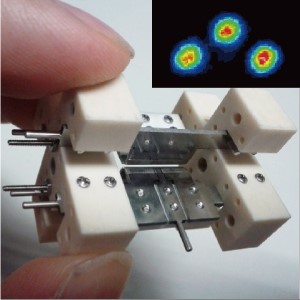Chapman University affiliated physicist publishes breakthrough paper on the Aharonov-Bohm effect in Nature
Chapman University affiliated quantum physicist Yutaka Shikano, Ph.D., has published a milestone paper in the prestigious journal
Nature Communications
. The title of the article is “Aharonov-Bohm effect with quantum tunneling in linear Paul trap.” The Aharonov-Bohm (AB) effect was proposed by Yakir Aharonov, who is the co-director of the Institute for Quantum Studies at Chapman University, and David J. Bohm in 1959.
The AB effect showed for the first time that a magnetic field inside a confined region can have a measureable impact on a charged particle which never traveled inside the region. This purely quantum effect, verified in a multitude of experimental set-ups, is at the heart of much of modern physics. In 1986, Akira Tonomura and his coworkers used electron holography (which is a key technology behind the electron microscope) to empirically prove the existence of the Aharonov-Bohm effect.

Another aspect of quantum theory is “tunneling,” a phenomenon in which a particle can go places where it is not allowed to go classically, and a fundamental component of the
Nature
paper. Applications of tunneling include nuclear fusion, the diode used throughout electronics, and different types of microscopes. Although it has been observed on large scales, no one has yet actually measured the tunneling of a single particle until now. Yutaka Shikano, who is an affiliated member of the Institute for Quantum Studies at Chapman and a research associate professor at the Research Center of Integrative Molecular Systems (CIMoS), Institute for Molecular Science and the Urabe group of Osaka University observed this effect for the first time.
The experiment was performed at Osaka University using an ion trap system. Due to recent developments of quantum technology, the team was able to manipulate the ground state of an ion using laser cooling. They used three calcium ions arranged in a triangular structure. The observed tunneling was between the upward and downward triangular configurations. When they changed the strength of the magnetic field, it showed that the likelihood of a transition oscillated as originally predicted by the Aharonov-Bohm effect.
Co-Director of the Institute for Quantum Studies, Prof. Jeff Tollaksen commented: “Quantum theory is considered by many to be the most successful theory in history and has led to a profound understanding of the microscopic world of atoms. Theoretical physics has yielded the most significant benefits for our society at the lowest costs. Discoveries in fundamental physics often lead to new industries: from electricity to smartphones to satellites. Quantum physics resulted in technological advances that drive our economy, such as the entire computer revolution, electronics, and the nuclear power industry. In addition, it impacts many other disciplines such as genetics, medicine and mathematics. Experts therefore estimate that nearly half the wealth created in the 20th century arose from quantum physics. At the Institute, we’re committed to producing the next generation of breakthroughs which will lead to the technology of the 21
st
century. Similarly, I’m sure this breakthrough of Prof. Shikano and co-authors will lead to many new applications, such as the ability to more carefully control a particle while it is tunneling.”
Consistently ranked among the top universities in the West, Chapman University provides a uniquely personalized and interdisciplinary educational experience to highly qualified students. Our programs encourage innovation, creativity and collaboration, and focus on developing global citizen-leaders who are distinctively prepared to improve their community and their world. For more information visit
www.chapman.edu
and quantum.chapman.edu.
Follow us on Facebook at:
Chapman University Facebook
On Twitter at:
@ChapmanU
On YouTube at:
Chapman University YouTube Channel
###
Categories
Recent Posts
- ANNETTE BENING, ED ASNER, AND GARY COLE JOIN CAST CRITICALLY ACCLAIMED PLAY BRINGS THE HUMAN EXPERIENCE OF WARFARE TO LIFE
- DISNEY EXECUTIVES AND OTHER ORANGE COUNTY LEADERS JOIN CHAPMAN UNIVERSITY GOVERNING BOARDS
- Chapman University’s Office of the Provost and Musco Center Presents Provost’s Arts & Lecture Series
- General H. R. McMaster visits to commemorate partnership between Chapman University and Richard Nixon Foundation
- More Category 5 Hurricanes Forecasted by Scientists
Archives
- October 2018
- September 2018
- August 2018
- May 2018
- April 2018
- March 2018
- February 2018
- January 2018
- December 2017
- November 2017
- October 2017
- September 2017
- August 2017
- July 2017
- June 2017
- May 2017
- April 2017
- March 2017
- February 2017
- January 2017
- December 2016
- November 2016
- October 2016
- September 2016
- July 2016
- June 2016
- May 2016
- April 2016
- March 2016
- February 2016
- January 2016
- December 2015
- November 2015
- October 2015
- September 2015
- August 2015
- July 2015
- June 2015
- April 2015
- March 2015
- February 2015
- January 2015
- December 2014
- November 2014
- October 2014
- September 2014
- August 2014
- July 2014
- June 2014
- May 2014
- April 2014
- March 2014
- February 2014
- January 2014
- December 2013
- November 2013
- October 2013
- September 2013
- August 2013
- July 2013
- June 2013
- May 2013
- April 2013
- March 2013
- February 2013
- January 2013
- December 2012
- November 2012
- October 2012
- September 2012
- July 2012
- June 2012
- May 2012
- April 2012
- March 2012
- February 2012
- January 2012
- December 2011
- November 2011
- October 2011
- September 2011
- August 2011

